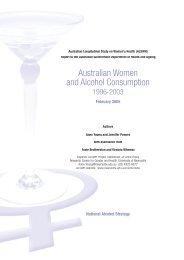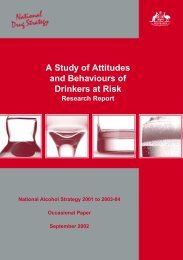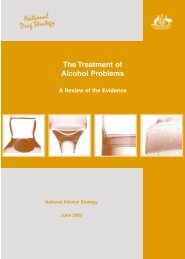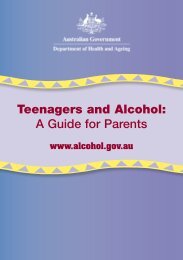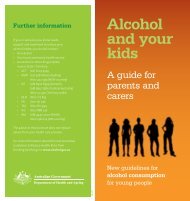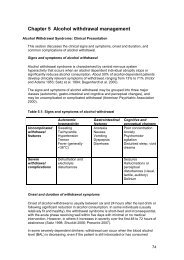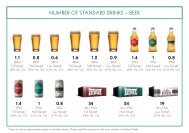Chapter 3 Screening, assessment and treatment planning - Alcohol
Chapter 3 Screening, assessment and treatment planning - Alcohol
Chapter 3 Screening, assessment and treatment planning - Alcohol
Create successful ePaper yourself
Turn your PDF publications into a flip-book with our unique Google optimized e-Paper software.
However, patients presenting with such problems should be screened for alcoholuse, <strong>and</strong> if appropriate, proceed to a more comprehensive <strong>assessment</strong>. Generalpractitioners <strong>and</strong> other health <strong>and</strong> welfare workers encountering these presentationsshould have screening systems in place.Biological markers of excessive alcohol consumptionBiological markers of excessive alcohol use include direct measures of alcohol (e.g.alcohol in breath or blood) <strong>and</strong> a range of indirect indices such as liver enzymesactivity, the levels of carbohydrate-deficient transferrin, characteristics of blooderythrocytes (e.g. mean corpuscular volume) <strong>and</strong> others.Measures of alcohol levels<strong>Alcohol</strong> concentrations may be measured in breath, blood <strong>and</strong> urine. Use of breathalcohol testing has been incorporated into Emergency Department practice by anumber of groups (Cherpitel 1995; Robinson et al. 1992; Walsh <strong>and</strong> Macleod 1983)as part of screening <strong>and</strong> brief intervention programs. There is evidence that suchprograms prevent readmission with alcohol-related trauma (Longabaugh et al. 2001).False positive detection may result from technical failure but may also be rarelyencountered in low levels due to endogenous production of ethanol (Spinucci et al.2006). Endogenous production of ethanol by yeasts is accentuated bygastrointestinal stasis <strong>and</strong> dietary sucrose <strong>and</strong> is reduced by antibiotics (Baraona etal. 1986).Recommendation3.8 Direct measures of alcohol in breath <strong>and</strong>/orblood can be useful markers of recent use <strong>and</strong>in the <strong>assessment</strong> of intoxication.Strength ofrecommendationDLevel ofevidenceIIIndirect MarkersA number of biological markers can be used to detect alcohol consumption:gamma glutamiltransferase (GGT), aspartate aminotransferase (AST), alanineaminotransferase (ALT), mean cell volume (MCV), carbohydrate-deficient transferrin(CDT) <strong>and</strong> uric acid (Conigrave et al. 2003; Hannuksela et al. 2007).Serum GGT, a liver enzyme, is elevated in 60-80 percent of alcohol dependentpeople (Conigrave et al. 2002). CDT has similar sensitivity to GGT but higherspecificity (Scouller et al. 2000). CDT results vary depending on the laboratorymethod used (the more commonly used modified test is less sensitive than theoriginal test) <strong>and</strong> consequently may be no more sensitive than GGT (Scouller et al.2000).A multi-site international study comparing CDT, GGT <strong>and</strong> AST found that CDT waslittle better than GGT in detecting high- or intermediate-risk alcohol consumption,although both were better than AST. CDT <strong>and</strong> GGT levels were influenced by bodymass index, sex, age, <strong>and</strong> smoking status (Conigrave et al 2002). False positivesoccur with most CDT test kits in the presence of advanced liver disease of any cause(Anton et al. 2001).24



